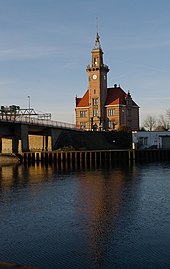LabLynx Wiki
Contents


Construction on Dortmund's port which terminates the Dortmund-Ems Canal connecting Dortmund to the North Sea started in 1895. It was opened 1899 by Kaiser Wilhelm. At the beginning of the 20th century it was mainly used for the import and export of wheat, coal and ore. The port was expanded in the 1920s and 1930s by adding new docks as well as on the administrative infrastructure (Dortmunder Hafenamt). Today Dortmund Port is the biggest European canal port with 10 docks and a pier length of 11 km.
Gaining its greatest importance after WW II, in 1972 6.2 million tonnes of good were shipped over the port. But even the completion of the container port in 1987 could not stop the gradual decline of the port resulting from the extinction of the coal and steel industries in Dortmund.

2.96 million tons of freight were shipped over the Dortmund Port in 2007, an increase of 7.1 percent compared to the previous year.[1]
| good | tonnage |
|---|---|
| Building materials | 934,000 t |
| Mineral oil | 647,000 t |
| Container | 523,000 t |
| Iron and steel products | 334,000 t |
| Scrap and recyclable waste | 216,000 t |
| Coal and coke | 272,000 t |
| Others | 34,000 t |
In the process of restructuring the industry in the Ruhrgebiet and in Dortmund, local politicians are looking for new ways to use the old port. Planned projects are the construction of a marina and high-quality areas for recreational use and residential redevelopment on the water.
In 2005 a first location for recreational use was established.
See also
References
- ^ "News" (in German). Dortmunder Hafen AG. 2008-02-21. Retrieved 29 February 2008. [dead link]
- ^ "Daten und Fakten" (in German). Dortmunder Hafen AG. Archived from the original on 28 September 2007. Retrieved 29 February 2008.


















